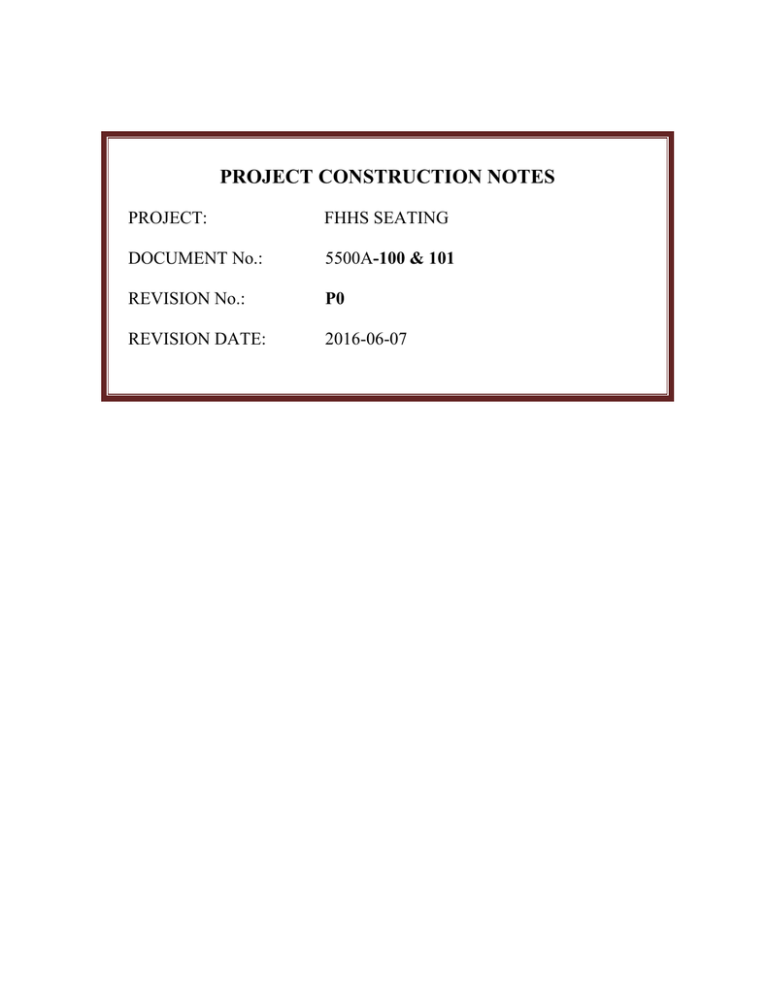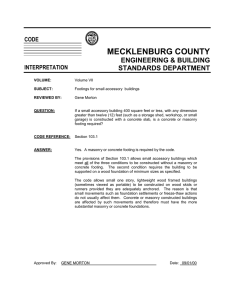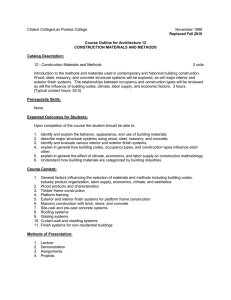fhhs seating construction notes
advertisement

PROJECT CONSTRUCTION NOTES PROJECT: FHHS SEATING DOCUMENT No.: 5500A-100 & 101 REVISION No.: P0 REVISION DATE: 2016-06-07 2 PROJECT CONSTRUCTION NOTES GENERAL 1. 2. 3. 4. 5. 6. 7. 8. All structural engineering drawings are to be read in conjunction with all relevant architectural and other consultants’ drawings. Refer any discrepancies to the Engineer in writing prior to commencement of work. Refer to other Consultants’ and Specialists’ drawings for service requirements. Obtain the Engineer’s written authorisation for all amendments prior to commencement of work. No drawing is to be scaled. Figured dimensions to be used at all times. Unless otherwise stated, Permissible Deviation (PD) will be to Grade II in terms of SANS 10155. The Contractor is to locate and identify existing services on site and to protect them for the duration of the works. The Contractor is required to comply with all the requirements of the Occupational Health and Safety Act (Act no 85 of 1993) as amended. EARTHWORKS 1. 2. 3. Site Clearance and Earthworks to be in accordance with SANS 2001-BS1 and 2001-BE1. Stockpile material only in approved locations on site or as indicated on the drawings. Approved selected cohesionless backfill around columns and walls, above bases and beneath surface beds, must be compacted to a minimum density of 100% Mod AASHTO in layers not exceeding 200mm thick unless otherwise specified. CONCRETE 1. 2. 3. 4. Concrete, formwork and reinforcement to be in accordance with SANS 2001-CC1. Reinforcement to conform to SANS 920, reinforcement detailing to conform to SANS 10144, and bending dimensions to conform to SANS 282. The cementitious binder shall, unless otherwise specified in note 6 below, be a blend (by mass) of 50% CEM I 42.5 and 50% GGCS (Ground Granulated Corex Slag). CEM I and GGCS to comply with the requirements of SANS 50197-1 and SANS 55167-1 respectively. For exposed concrete (including concrete on or below ground) made with alkali-reactive coarse aggregate, the total alkali content (i.e. the product of the Na2O-equivalent of the cementitious binder and the binder content of the concrete) must be limited to the following values: Total Na2O equivalent (kg/m3) 2,0 2,1 4,0 Rock Type Witwatersrand Supergroup quartzite/shale Malmesbury Group metasediments Cape Granite 5. Required limiting values for concrete mix design purposes (for reinforced concrete structures near to or on the coast, i.e. exposed to airborne salt but not in direct contact with sea water): Element Description Concrete Class (fcu in MPa) Aggregate Maximum Size (mm) W/B Ratio Note (a) Unreinforced concrete (e.g. mass concrete, blinding & 15 19 strip footings Concrete surface beds (External 25 19 External Precast units) 35 19 Notes: (a) fcu = Required minimum characteristic compressive strength at 28 days Note (b) 0,65 0,45 Note (c) Note (c) 3 (b) W/B Ratio = Maximum Water/Binder Ratio (c) Cementitious Binder Blend: 70% CEM I/30% GGCS 6. 7. 8. 9. 10. 11. 12. 13. 14. 15. Ground slabs to be cast on selected clean cohesionless material, compacted to 100% Modified AASHTO density. Unreinforced slabs to be cast in approximately square panels with maximum side length not exceeding 30 times the slab thickness. All joints to be positioned and formed in accordance with detail drawings. All movement joints to be 10mm wide, formed by gluing an approved closed cell expanded polyethylene joint filler to the 1st cast concrete. Joint sealing to Architect’s specifications. All bases are located centrally underneath columns unless otherwise specified. All foundations are to be founded on competent material, and final founding levels are to be determined in consultation with the Engineer. Provide 50mm unreinforced concrete blinding under all bases. Minimum concrete cover to any reinforcing bar, including links, to be as tabulated below unless otherwise specified: Slab surfaces (PC Units): External................................................. 40mm Provide all exposed concrete corners with 25mm x 25mm chamfers, unless otherwise specified. Standard of precast concrete finish to be to smooth. Curing and protection of concrete shall be carried out strictly in accordance with Clause 4.7.13 of SANS 2001-CC1. Quality control: All mix designs to comply with SANS 10100-2:2014 and to be submitted to the Engineer for approval, prior to any concrete being cast. Testing of concrete to be in compliance with SANS 2001-CC1 and SANS 10100-2:2014. All testing to be carried out by an approved independent laboratory. Frequency of testing: At least one sample (a sample being 3 concrete cubes) for 28 day testing shall be taken from each day’s casting, and from at least every 50m3 of concrete of each mix design placed per day. Initially, for the first 3 pours of every mix design, an additional sample (a sample being 3 concrete cubes) to be taken and tested at 7 days. The Contractor may elect to continue taking additional 7 day test cubes for early strength testing, to his account. These shall not be used for assessment of strength as per the above testing procedures. A concrete control register to be kept on site recording the following for each cube result: a. Unique cube number b. Location placed c. Concrete mix description and source, e.g. ready mixed concrete or site batch, to be clearly identified d. Date cast e. Date tested f. Age tested All cube test results to be submitted to the Engineer within 1 week of the test date. No-fines concrete blocks must be tested to confirm adequate permeability performance. MASONRY WALLING 1. Refer to the relevant Engineer’s drawings for setting out and details of all masonry walls. 2. Refer to Engineer’s details for joints in brickwork and connections to steel and concrete. 3. Strip footings, pad footings and ‘slab-on-the-ground’ foundations for masonry walling to be constructed in accordance with SANS 2001-CM2. 4. Masonry walls to be constructed in accordance with standards and tolerances of SANS 2001-CM1, SANS 10164-1 and SANS 10145. 5. Masonry walls to be constructed using cement complying with the requirements of SANS 50413-1 type MC 5. 4 6. 7. 8. 9. 10. 11. 12. 13. 14. Masonry walls to be constructed using mortar Class II to SANS 10164-1 (1 part cement : 1 part lime : 6 parts sand) unless otherwise specified. Mortar testing to be carried out in accordance with Section 6 of SANS 10164-1. Clay bricks to comply with SANS 227. They should have moisture expansion properties not exceeding Category II limitations and must not be laid earlier than six weeks after removal from the kiln. Concrete masonry units to comply with SANS 1215. These units shall not be wetted prior to laying. All unfinished walls shall be protected against moisture entry during construction interruptions by providing effective covers over the tops of such walls. The Engineer may require that samples of masonry units be submitted for laboratory testing in accordance with SANS 10164-1. Loadbearing walls: Provide a slip layer comprising 1 layer of 3-ply malthoid on a smoothly trowelled mortar bedding (with 2 layers of continuous brick reinforcement in the top 2 courses) at the wall/slab interface. Loadbearing walls must not be chased either vertically or horizontally without the prior approval of the Engineer. Required characteristic compressive strength of loadbearing masonry wall units: All foundation walls and loadbearing walls………………..14 MPa (Class NFX or FBX only) All other walls…………………..7 MPa (Class FBS, FBA or NFP to Architect’s specification). All metal ties/straps, brick reinforcement and closure plates to be galvanized. DPC used in masonry walls to be rough-surfaced, e.g. “Brickgrip” or approved equivalent. Brick reinforcement (2,8mm minimum diameter longitudinal wires): Install with 250mm minimum lap lengths, properly tied in at corners and wall junctions. Spacing as follows, unless otherwise specified: Walls generally: TYPE OF MASONRY UNIT Concrete masonry units Metric sized units Imperial sized units APPROX. COURSE HEIGHT 200mm 125mm 85mm REINFORCEMENT SPACING Every 2nd course Every 3rd course Every 4th course Foundation walls: install in every course. 15. Hoop iron ties/straps (1,6mm thick x 32mm wide): Install as shown in details, 1 per skin, at: Junctions of masonry walls and RC columns/walls, unless otherwise specified. Junctions of masonry walls and steel columns, unless otherwise specified. Movement joints in masonry walls. Spacing as follows, unless otherwise specified: TYPE OF MASONRY UNIT Concrete masonry units Metric sized units Imperial sized units APPROX. COURSE HEIGHT 200mm 125mm 85mm SPACING OF TIES Every 2nd course Every 3rd course Every 4th course Truss/rafter anchorage: build straps into beam filling for a minimum depth of 600mm unless otherwise specified. 16. Concrete infill in concrete masonry block walls [1 part cement : 4 parts sand : 3 parts 9mm stone (fcu ~ 15 MPa)]: Foundation/retaining walls: construct walls in increments not exceeding 1 metre in height, and delay concrete infill work until the walls have achieved adequate strength. 17. Movement joint former (10mm thick closed cell expanded polyethylene strips, e.g. “Sondor Jointex”): At junctions of masonry walls and RC columns/walls, unless otherwise specified. At junctions of masonry walls and steel columns, unless otherwise specified. At movement joints in masonry walls. Between top of non-loadbearing walls and soffits of slabs and/or beams over.




